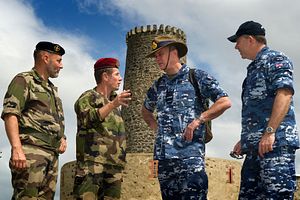In the past two years the strategic relationship between Australia and France has begun to consolidate considerably. It seems Australia views its relationship with France as increasingly important for the Asia-Pacific region. With 1.6 million French citizens living in France’s Pacific territories, and a significant amount of naval hardware and troops stationed in the region, France maintains a presence as a regional power. France also continues to be one of the few powers that have naval capabilities of a global reach.
The most prominent indication of these strengthening ties was Australia’s decision in April 2016 to have its new fleet of submarines built by the majority state-owned French company Naval Group (formerly DCNS), at a cost of US$39 billion. The French tender beat out what was considered by some as a stronger Japanese proposal. The submarines will be phased into Australia’s fleet between mid-2030 and 2050, indicating that the countries will be working intimately for at least the next three decades.
The submarine deal was signed two months after the release of Australia’s 2016 Defense White Paper, which indicated that France was a key collaborator — alongside the United States, New Zealand, and Japan — for Australia’s regional security. Continuing the trajectory, in September 2016, at the annual Pacific Islands Forum (PIF), France’s Pacific territories of New Caledonia and French Polynesia were admitted as full members to the South Pacific’s primary multilateral framework. That decision was undoubtedly taken at Australia’s behest, and marked a sharp reversal of the PIF’s previous policy toward France, with significant implications for the forum (discussed in the September issue of the The Diplomat Magazine).
Until recently France was seen as a more disruptive force within the Pacific. France conducted extensive testing of its nuclear weapons between 1966 and 1996, maintained a obstructionist posture toward any independence movements in the region, and blew up the Greenpeace vessel, the Rainbow Warrior, in Auckland harbor in 1985. That France is now being warmly embraced by Australia, and as a result the wider Pacific community, indicates that previous concerns about French involvement in the Pacific are being outweighed by larger concerns about more significant geopolitical shifts.
France already engages in some significant regional security architecture. It is a member of the Quadrilateral Defense Coordination Group (QUAD), along with the United States, Australia, and New Zealand, which coordinates maritime security cooperation in the Asia-Pacific. Alongside this, France is also part of the France-Australia-New Zealand (FRANZ) agreement designed to coordinate regional humanitarian relief operations in the region. French military forces based in New Caledonia host the biennial Croix du Sud, or Southern Cross, humanitarian relief exercise, which includes participants from states within and bordering the Pacific. A French frigate will be involved in anti-submarine warfare drills with Australia’s current submarine fleet off the coast of Western Australia in coming weeks, and France will also soon base its logistics ship for its Antarctic operations in Hobart for half of the year.
Alongside these areas of cooperation, recent comments made by the chief of the French navy, Admiral Christophe Prazuck, give a good indication about why the relationship between Australia and France is being further consolidated, and what the future may hold. Prazuck was in Sydney in early October for the Pacific 2017 International Maritime Exhibition, and while there he made the suggestion that Australia and France could potentially conduct joint Freedom of Navigation (FON) patrols in the South China Sea. Clearly France maintains a strong concern about China’s threat to the status quo in the region.
France has increasing economic interests in the Asia-Pacific region, and status quo access to the South China Sea remains crucial to its ability to move its military hardware between its European, Indian Ocean, and Pacific Ocean bases. Paris supports the United Nations Convention on the Law of the Sea (UNCLOS) as the prevailing norm that serves its interests well, a norm China is currently challenging. Australia currently does not participate in any Freedom of Navigation exercises in the South China Sea, but it remains a prominent debate within Australia security circles, and is also subject to outside encouragement. Prazuck has now further contributed to that encouragement.
For Australia, forging closer security ties with France — a like-minded state with significant capabilities and added diplomatic muscle — seems to be the best regional hedge against current U.S. political instability. Australia is unable to ascertain whether this instability is an aberration or long term, and whether it may lead to a U.S. retrenchment from the Asia-Pacific region. Therefore encouragement of a greater French role — one France seems keen to employ — in the Pacific and its surrounds seems to be Australia’s best strategic move at defending a status quo that has served Australia’s interests well.

































